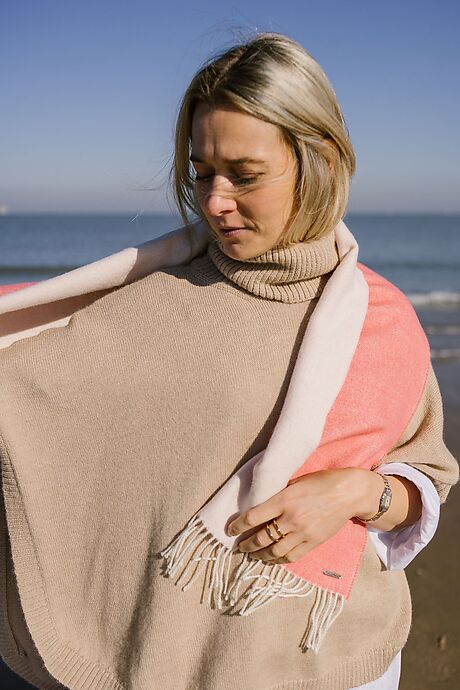Raynaud's foot syndrome

Raynaud's syndrome is a vascular disorder that mainly affects the extremities, such as the fingers and toes. It is characterized by episodes of excessive constriction of the small arteries, leading to reduced blood circulation and a reduced supply of oxygen to the affected tissues. These episodes can be triggered by cold, stress or anxiety, but can be cured with effective natural treatments, and above all through prevention with socks and gloves that provide effective protection against the cold.
Origin of Raynaud's syndrome
Raynaud's syndrome is a medical condition characterized by a temporary reduction in blood flow to the extremities of the body, mainly the fingers and toes, resulting in paleness, coldness and numbness. Its precise origin remains a subject of research, but several factors are generally associated with its onset.
Primary Raynaud's syndrome occurs without any identifiable underlying cause, and is often seen as an over-reaction to cold or emotional stress. Women are more likely to suffer from it than men, and it is usually diagnosed in young adults.
Secondary Raynaud's syndrome is caused by another underlying medical condition, such as scleroderma, systemic lupus erythematosus, rheumatoid arthritis or giant cell arteritis. In these cases, Raynaud's is considered a symptom of the underlying disease, rather than a separate entity.
The exact mechanism that triggers narrowing of the small arteries that supply the body's extremities is not fully understood. However, it is widely accepted that constriction of the blood vessels is due to an excessive response of the sympathetic nervous system, which regulates vascular tone. In response to a stimulus, such as cold or stress, the vessels contract, limiting the blood supply and causing the characteristic symptoms of Raynaud's syndrome.
In summary, although the exact origin of Raynaud's syndrome is not yet fully elucidated, it appears to result from a combination of genetic, environmental and neurovascular factors. Advances in our understanding of this condition will enable us to develop more effective treatment strategies and provide greater relief for sufferers.
Symptoms of Raynaud's disease
Symptoms can vary in intensity from one person to another, and can be triggered by a number of factors.
One of the most common symptoms is a change in skin color. During a Raynaud's attack, the affected extremities may turn pale, sometimes almost white, due to reduced blood flow. This pallor is usually followed by a phase of cyanosis, when the skin takes on a bluish hue due to lack of oxygenation. Finally, when blood circulation is restored, the skin may turn red, causing a sensation of heat.
Another common symptom is a sensation of coldness and numbness in the affected fingers and toes. Raynaud's sufferers can experience extreme sensitivity to cold, even at moderate temperatures, which can cause considerable discomfort. Numbness is also common, and can make it difficult to use fingers or toes during an attack.
Sometimes, Raynaud's syndrome is accompanied by pain or tingling in the affected extremities. These sensations can be described as burning or electric shocks, and can be quite uncomfortable. Raynaud's sufferers may also notice a reduction in sensitivity to touch during attacks.
It's important to note that Raynaud's symptoms are generally reversible and disappear once blood circulation is restored. However, attacks can last from a few minutes to several hours, and in rarer cases can lead to complications such as skin ulcers or infections.
Treatments for Raynaud's syndrome
Treatment of Raynaud's syndrome is primarily aimed at relieving symptoms, preventing attacks and improving blood flow to the affected extremities. Treatment approaches vary according to the severity of symptoms and the presence of an associated underlying disease.
Self-care measures and lifestyle changes are often recommended first. Raynaud's sufferers are advised to avoid exposure to the cold and to use warm clothing to maintain an adequate body temperature. Stress management is also important, as emotional stress can trigger Raynaud's attacks. Stopping smoking is essential, as nicotine can restrict blood vessels. Regular exercise and relaxation techniques, such as meditation or biofeedback, can also help improve blood circulation.
In more severe cases, or when self-care measures are not sufficient, medication may be prescribed. Vasodilators, such as calcium channel blockers, are commonly used to relax the muscles of the blood vessel walls and improve blood flow. Angiotensin-converting enzyme (ACE) inhibitors can also be used to dilate blood vessels. In some cases, drugs that act on the sympathetic nervous system, such as alpha-blockers, may be prescribed to regulate vessel constriction.
In conclusion, treatment of Raynaud's syndrome focuses on relieving symptoms, preventing attacks and improving blood circulation. Self-care measures, lifestyle changes, vasodilator medication and, in some cases, surgery are all possible options. It is important to consult a healthcare professional to determine the best treatment plan for each individual, based on the severity of symptoms and the presence of underlying diseases.
The main prevention: alpaca wool for warmth in all circumstances

Alpaca wool is known for its exceptional insulating properties, making it an ideal choice for preventing the cold in all circumstances. This natural fiber, derived from alpaca down, is much warmer than sheep's wool and offers protection against extreme temperatures. Alpacas are native to the mountainous regions of the Andes, where they are exposed to harsh climatic conditions. Its wool has developed over time to protect it from temperature variations, offering optimal thermal insulation.
Alpaca wool has several characteristics that make it an excellent choice for people suffering from Raynaud's syndrome. Firstly, it is naturally soft and non-irritating, which is important for people with heightened skin sensitivity. In addition, its unique structure retains body heat, helping to maintain a stable temperature and avoid sudden variations that could trigger a Raynaud's attack.
What's more, alpaca wool is highly breathable, which means it allows moisture to evaporate quickly, preventing the damp, cold feeling caused by perspiration. It is also hypoallergenic, making it a safe option for people with allergic sensitivities.
By wearing alpaca wool garments such as sweaters, scarves or socks, you can enjoy natural, regulated warmth, without having to worry about Raynaud's attacks triggered by the cold. Alpaca wool offers effective protection against low temperatures by maintaining a thermal barrier between the body and the outside environment.
Discover BellePaga products, 100% alpaca wool products made in Peru by locals with ancestral know-how.
-
Quawana Scarf
99,00 €
-
Dante Sweater
- M
- L
- XL
229,00 €



.png)



